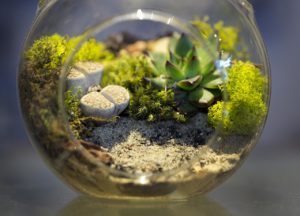Interests in owning a terrarium have been increasing every year mainly because of the way information is spreading throughout the world. We have the ability to quickly share files, share ideas, ask questions, and spreading information that can possibly influence over 4.5 billion people.
The internet helped many new people understand the meaning of terrarium including other types of vivariums, which led to a surge in questions throughout the internet with many of them unanswered.
Thousands of questions are left alone and neglected for years without a hint of traffic. 🙁
After doing a little research, there was one question that stood out to me amongst the many other questions – a question that involves snails. This person asked:
Can a snail live in a terrarium?
The answer? It really depends because the question isn’t quite specific enough. Answering a simple yes or no would mean that there are no right or wrong answers. And I’ll tell you why in a moment.
Before we get started, let’s take a brief moment and compare the differences when it comes to terrarium vs. paludarium. This is recommended and might help you with ideas if you’re planning on raising snails. To give you a brief summary between the two:
- Terrarium – a type of vivarium that’s known for its low humidity. They are usually a desert-like mini-environment.
- Paludarium – a type of vivarium that has both land and water. This type of vivarium is usually rainforest-like with high humidity.
Are you ready to get started?

Let’s begin 🙂
Keeping Snails As a Pet

Some people hate snails and others love them with a passion. Which one are you? There are many reasons to why you should keep snails as a pet and in case you’re wondering, here are the reasons:
- Snails are quiet and a peaceful creature to have as a pet.
- There are not too many responsibilities when it comes to raising snails.
- Setting up isn’t too expensive. That’s if you don’t want to raise them in your terrarium.
- They’re one of the slowest creatures but at the same time, they’re interesting to watch.
- Having a snail is a unique pet and that’s special enough!
- Feeding them can be quite easy. You can feed them leftovers from your refrigerator!
Finding Your Snails: Where can you go?
Finding Garden Snails: You can find snails almost anywhere! Most of the time, you can find them in your garden, near your front lawn, or even next to your neighbors’ house. My grandparents have a vegetable garden and when I come for a visit, we would come across snails usually in the morning or night time.
Did you know? 💡 When it comes to the garden snail, they’re recognized as plant pests because they consume stems and leaves of crops.

But let’s say you don’t want the typical basic garden snails. Where do you find the unique looking types of snails?
- Pet store – One way you can get awesome looking snails is by going to your local pet shop. You can find a variety of snail types that’s much better looking than the garden snails.
- Order online – You could always order your snails online by clicking here.
The only difference between the two is that you have to wait for shipping when ordering your snails online. This really depends on what is more efficient for you.
Raising Snails in a Terrarium: Is it Possible?
Now for the one million dollar question – can you raise snails in a terrarium? You can answer yes or no, but you won’t fully understand until you know that there are two types of terrariums. The two kinds of terrariums would be an open terrarium and a closed terrarium.
- Open Terrarium – This type of terrarium doesn’t require lids and they’re usually open. Most of the time, this type of terrarium requires you to water the plants.
- Closed Terrarium – For a closed terrarium, you probably get the idea. This type of terrarium works with a sealed or closed lid. There are closed terrariums that are completely sealed creating a self-sustaining ecosystem with the help of the water cycle.
Even when there aren’t many responsibilities when you’re raising a snail, there will be if your terrarium is a tiny jar. For people with a terrarium tank that’s meant to keep life, then it should be much easier.
The reason why it’ll be difficult to keep your snail in a jar: When you keep snails as pets, you have to understand that they need a mix of foods. This includes calcium and protein. This is why a snail will unlikely last in a jar.
“I still want to use my jar terrarium, do I use an open terrarium or closed terrarium?”
If you still want to proceed by keeping your snails inside of a jar, then the recommended terrarium would be a closed terrarium. This will help prevent the snails from escaping. You should also add a water dish to keep water for the snails and create a hole to keep air entering and escaping for your snail.
Did you know? 💡 Wild snails can live from 2 to 5 years while snails that are kept in captivity can survive up to 15 years.
Things To Keep In Mind About Keeping Snails As Pets
Before you decide to keep a snail as a pet, either by purchasing it or rescuing it from the wild, beware that not all species can survive in a terrarium.
Only the various species of the terrestrial i.e. land snails can easily adapt to life in a terrarium.
These terrarium snails are low-maintenance and may even appreciate being taken care of.
These species can be found in the natural environment or can be bought from exotic plant dealers.
You may adopt any of the following:
- common brown garden snail
- the tiger snail
- the Helicodiscus
- and a few others
(I would advise asking the supplier details of all the terrarium species).
Snail Necessities
Since you have to feed the snail yourself, keep in mind the necessities (mainly diet):
- Water
- Calcium
- Protein
- Vegetables
- Fruits
- Etc.
However, you can feed them only once a day or every other day.
Did you know?
All the fruits and vegetables need to be thoroughly washed and dried to remove any remaining chemical or pesticides; remove the skins from hard vegetables like potatoes or fruits like apples to be extra cautious.
Moreover, if you want to give potatoes or carrots, make sure that apart from being skinned, they should also be boiled and cooled.
Don’t Forget To Cut The Products
All the products should be cut up in small pieces; remove the remaining food before it rots and unbalances the PH level of the soil, or pollute the air inside the tank with the stink of rotting produce.
Advice: You should give leafy greens in every meal.
Fruits They Enjoy
Furthermore, I have observed that these snails highly enjoy fruits like:
- Mangoes
- Bananas
- Berries
You should certainly add these to their diet.
Maintain Your Snails’ Shells
Most importantly, in order to build and maintain their delicate shells, calcium is vital for them – without which their shells could deteriorate and diminish with time.
Thus, a convenient calcium source I add to the triennium is Cuttlebones (they are easily available from stores, as they are usually fed to birds).
Tip: A convenient calcium source can also be crushed eggshells.
Lastly, protein is also important: place a small piece of meat alongside the other components of their diet.
If you have added any tank mates, critters, or earthworms, then place all the food directly on the soil and not on any plate, so the other creatures can also be sufficiently nourished.
As they can easily drown (but enjoy bathing as well), add a shallow dish; avoid bottled, chlorinated water, instead use fresh tap water.
(I boil the water and cool it down before adding it to the dish, as an extra precaution)
Since these mollusks are sensitive creatures, they should be efficiently taken care of and all the required necessities should be fulfilled.
Otherwise, they will not be able to cope with the change of their natural habitat and may die.
What You Need
The first stage is to build the terrarium: find any moderate-sized box with a lid (as snails are slow, they do not require much space to roam); a glass tank is preferable over a plastic box, but both can be used.
(I would recommend a glass tank, even if it is more costly)
Furthermore, a thick layer of soil is added as the base, this needs to be of an alkaline nature and sterilized (you can do this at home or purchase the suitable substrate from any gardening shop).
Each snail has varying behaviors, thus by observing them, various additions can be made for example adding rocks, pots, branches, twigs, etc.
Tip: Refrain from adding a water body, as they can drown.
In addition, these creatures prefer to feed on plants so add any ferns or moss in the terrarium as well; don’t use plants that require a lot of sunlight, as sunlight is detrimental for the snail’s health.
Mollusks And Humidity
These mollusks require an adequate level of humidity, not too high and not too low, for survival.
Thereby, put holes or windows in the lid of the box. You should be aware that snails can climb smooth surfaces as well; hence a lid is a necessity, no matter how high the boundaries are.
If the concentration of the plants increases (also in height), then the lid of the container is not needed, as they would climb the plants, rather than the walls of the tank.
Lastly, to keep the atmosphere of the terrarium healthy, add critters or earthworms, which maintain the cleanliness and improve the quality of the soil.
(both are harmless for the snails and their eggs!)
Avoid These With Your Snails
A few things to be avoided are the following:
- Citrus fruits and vegetables, for example, oranges, lemons, and tomatoes.
- Sharp furnishings in the tank.
- Hard materials like ceramic pots or plates; hard plants like terra cotta. (The snails may fall on them and break their shells, which is fatal for them).
Don’t forget: Another aspect to remember is that snails are nocturnal creatures, they will usually be active at night.
Thus, I would suggest that you feed them at night because if you place the produce, protein, and calcium sources in the daytime, it may start to decompose before they even feed on them (snails favor a fresh diet).
Don’t Disturb Them
Furthermore, they should not be disturbed (by being touched, removed from the terrarium, tapping on the walls of the container, placed in the light, etc.) in the daytime, as it may mess up their sleep schedule, which may be detrimental for them.
On top of that, they should be delicately handled.
I would suggest that you do not remove them from their customized terrariums (except when you clean the container).
Now, the next section is a pretty interesting one. You’ll find out why. 🙂
Boredom Made Me Calculate a Snail’s Mile Time

After spending some time researching and reading about snails, I learned that the speed of a snail is around 0.5 to 0.8 inches per second. Being the curious person that I am, I decided to take out my calculator and do a little calculation.
I found a converter that helped me convert miles to inches and discovered that one mile is equivalent to 63,360 inches. I then used the snail’s slowest time (0.5 inches per second) to do a division.
Then I added 63,360 inches into the calculator divided by 0.5 inches leaving the resulted number of 126,720. This number is how many seconds a snail can travel a minimum of one mile.
Ending up with 126,720 seconds, I divided the number by 60 seconds, which left me with 2,112 minutes. I divided 60 minutes in order to get the answer in hours and the end result was 35.2 hours. This result is this fun fact right below:
Did you know? 💡 It takes a snail a minimum of 35.2 hours to complete a full mile.
From VivariumTips,
In conclusion, terrestrial snails have a high probability of survival in trienniums; other types of snails can rarely cope with the change. You will succeed easily in keeping your pet snail alive, only if you fulfill their diet and living requirements.
If this article interests you in any way, then you might like my recent articles about aquarium shrimps.
Snail-Related Articles:
If you have any questions or feedback, don’t hesitate to comment below this post. Your comments will help provide more information for future readers.
How do I support VivariumTips?
- The best way to support this blog is to share any articles on this website with your friends.
Check this interesting video out:





